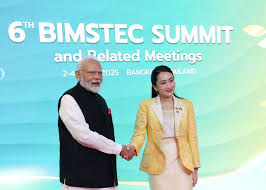A regional revival : On the BIMSTEC summit.
BIMSTEC summit provided a platform for bilateral meetings.
Last week’s Bay of Bengal Initiative for Multi-Sectoral Technical and Economic Cooperation (BIMSTEC) summit — the sixth — which brought the leaders of seven neighbouring countries to Bangkok at a time of global turbulence, was an opportunity to reignite the regional grouping after years of stasis. Originally cast as a “bridging” mechanism between South Asia’s SAARC and South East Asia’s ASEAN countries, the grouping has languished due to a lack of purpose or due to political underpinnings. After the collapse of India-Pakistan ties, post-2014, SAARC has made little movement, whereas the micro-grouping of Bangladesh-Bhutan-India-Nepal ran aground after the Bhutanese Parliament rejected the Motor Vehicles Agreement between them, as a result of which New Delhi has invested in BIMSTEC. While the objective of having a summit every two years was derailed by the COVID-19 pandemic, what is important is that the summit was held in spite of a possible derailment after the earthquake in Myanmar and Thailand. But the summit proved useful, given the number of agreements and areas of cooperation. These include a BIMSTEC chamber of commerce and work on the India-Myanmar-Thailand Trilateral Highway that will connect India’s North-East region, billed a BIMSTEC “hub”, all the way to the Pacific ocean. The BIMSTEC region is prone to natural disasters and building a joint mechanism for disaster management is critical. Negotiating a free trade agreement (FTA) and Customs agreements are among other plans outlined in a ‘Vision 2030’ document that was adopted.
Apart from the multilateral outcomes, the summit provided the leaders a rare opportunity for bilateral meetings. Prime Minister Narendra Modi and Bangladesh Chief Adviser Muhammad Yunus put aside months of acrimony and aired their grievances over the treatment of minorities, border killings and former Prime Minister Sheikh Hasina’s stay in India. Mr. Modi’s advice that “ rhetoric ” must be avoided between neighbours is important, but must be followed in Dhaka and Delhi. Mr. Modi’s meeting with Nepal leader K.P. Sharma Oli came after months of tensions over India’s refusal to issue Mr. Oli an invite, and it is hoped that these exchanges will lead to an early visit and the resolution of issues. The inclusion of Myanmar’s Prime Minister General Min Aung Hlaing was a special gesture by the BIMSTEC grouping, and it is hoped that Mr. Modi’s counsel to Gen. Min and Mr. Yunus on restoring democratic processes in Myanmar and Bangladesh will be heeded. While the summit was productive, many of its initiatives are replicas of agreements once adopted by SAARC, and it is important that member-states focus on the group’s cohesion and sustainability so that BIMSTEC is not allowed to atrophy the same way as SAARC did.
